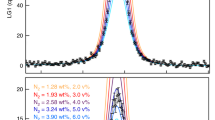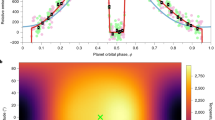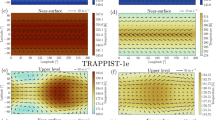Abstract
MEASURED brightness temperatures of Titan in the 8 to 14 µm range are too high to be produced by simple equilibrium with solar radiation, but at 20 µm the temperature is more in line with the equilibrium value1,2. An atmospheric “greenhouse” has been invoked to explain these observations, but the amount of hydrogen required to provide the appropriate infrared opacity is much larger than the observed value3,4. Models including large amounts of helium and methane have been considered by Pollack5; Hunten6 has suggested nitrogen as a possible opacity enhancing agent.
This is a preview of subscription content, access via your institution
Access options
Subscribe to this journal
Receive 51 print issues and online access
$199.00 per year
only $3.90 per issue
Buy this article
- Purchase on Springer Link
- Instant access to full article PDF
Prices may be subject to local taxes which are calculated during checkout
Similar content being viewed by others
References
Allen, D. A., and Murdock, T. L., Icarus, 14, 1 (1971).
Morrison, D., Cruikshank, D. P., and Murphy, R. E., Astrophys. J. Lett., 173, L143 (1972).
Trafton, L., Astrophys. J., 175, 285 (1972).
Sagan, C., Icarus (in the press).
Pollack, J. B., Icarus (in the press).
Hunten, D., Comments Astrophys. Space Phys., 20, 149 (1972).
Kuiper, G. P., Astrophys. J., 100, 378 (1944).
Trafton, L., Astrophys. J., 175, 295 (1972).
Trafton, L., Bull. Am. astr. Soc., 4, 367 (1972).
Kuiper, G. P., in The Atmospheres of the Earth and Planets (edit. by Kuiper, G. P.), ch. 12 (University of Chicago Press, 1952).
Cameron, A. G. W., in Origin and Distribution of the Elements (edit. by Ahrens, L. H.) (Pergamon, Oxford, 1968).
Jeans, J., in Dynamical Theory of Gases, ch. 15 (Dover, New York 1954).
Spitzer, L., jun., in The Atmospheres of the Earth and Planets (edit. by Kuiper, G. P.) (University of Chicago Press, 1952).
Greenspan, J. A., and Owen, T., Science, 156, 1489 (1967).
Lewis, J. S., Icarus, 10, 393 (1969).
Cess, R. D., and Khetan, S., J. quant. Spectrosc. radiat. Transfer (in the press).
Kiss, Z. J., and Welsh, H. L., Can. J. Phys., 37, 1249 (1959).
Dollfus, A., in The Solar System, 3 (edit. by Kuiper, G. P., and Middlehurst, B. M.) (Chicago, 1961).
Veverka, J., Icarus (in the press).
Zellner, B., Icarus (in the press).
Joyce, R. J., Knacke, R. F., and Owen, T., Astrophys. J. Lett. (in the press)
Author information
Authors and Affiliations
Rights and permissions
About this article
Cite this article
CESS, R., OWEN, T. Effect of Noble Gases on an Atmospheric Greenhouse (Titan). Nature 244, 272–273 (1973). https://doi.org/10.1038/244272a0
Received:
Issue Date:
DOI: https://doi.org/10.1038/244272a0
This article is cited by
-
The atmosphere of Titan
Journal of Molecular Evolution (1982)
-
The outer solar system: Perspectives for exobiology
Origins of Life (1974)
Comments
By submitting a comment you agree to abide by our Terms and Community Guidelines. If you find something abusive or that does not comply with our terms or guidelines please flag it as inappropriate.



